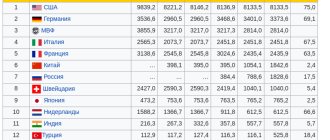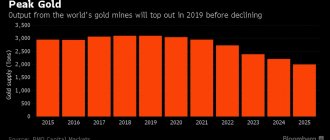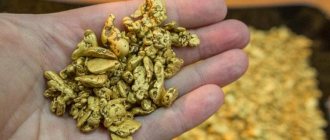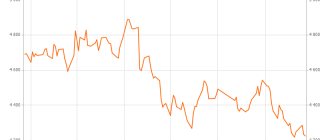Post updated: May 26, 2020
The world has been mining gold since ancient times. Over the entire period of this type of industry, about 170 tons of gold were mined. Half of the mined metal is used to produce jewelry, which is quite expensive. Scientists have found that if you collect the entire world's gold reserves in one place, you will get a huge cube, the height of which will be about thirty meters.
Golden story
Gold is a metal, a mineral that became known to mankind about six and a half thousand years ago. The oldest is considered to be a gold treasure that was discovered in the Varna necropolis, located in Bulgaria.
With the advent of this precious metal, the life and development of mankind dramatically changed its movement. Even today, gold is a profitable material for investing your own money. Over thousands of years, various currencies have come and gone, but this metal still holds significant value.
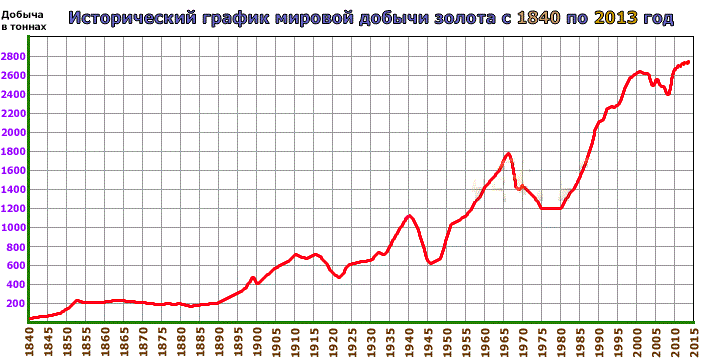
Those who have gold reserves in their possession have prestige and influence. In ancient times, the amount of gold not only assessed the level of wealth, but also acquired a certain place in society. Such features have survived to this day.
Today, the production of the entire gold reserve is divided by country.
It was gold reserves that became the cause of many wars and armed conflicts. Gold laid the foundation for the creation of the following concepts:
- Monetary system of payment for goods and services;
- Creation of cultural values and architectural monuments.
By studying gold with the aim of producing it on a large scale, scientists discovered many new chemical elements and certain reactions, and seekers of this precious metal opened up new territories and peoples to the world.
Gold price statistics
National paper currencies of all countries tend to devalue. While gold reserves are limited. Therefore, cost statistics show a constant increase in the indicator. The price for the yellow metal was first set by Newton in the 18th century - 4.24 pounds sterling per troy ounce (31.1 grams). For two centuries, the cost remained almost unchanged. At the beginning of the 20th century, quotes rose sharply, reacting to the military events of those years.
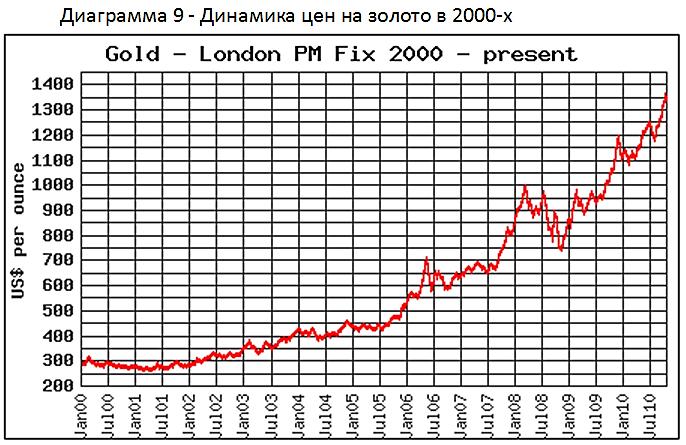
Long-term investments in gold are the most profitable. For example:
- over 100 years (1917–2017) quotes increased almost 64 times;
- over 10 years (2001–2011), the troy ounce rose in price by more than 7.5 times - from 254 to 1923 dollars.
The dynamics of gold prices (week, month, quarter) can be tracked online at the link - yandex.ru/news.
How gold is mined in Russia
Global gold mining has spread to dozens of countries. The Russian Federation is no exception. There are very few nuggets on the surface of the earth, but there are so many such places underground that it ranks fourth in gold production in the world. The state contains 7% of the world's gold reserves.
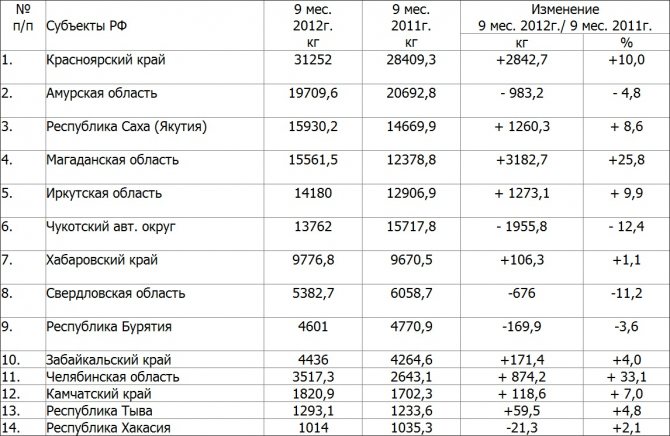
Distribution by constituent entities of the Russian Federation.
The extraction of gold reserves using industrial methods began in 1745. The discoverer of the precious metal mine was Erofey Markov, who told everyone about his discovery. At the moment, there are more than fifteen Russian companies that professionally mine the precious metal.
The extraction process itself is quite labor-intensive and time-consuming. It requires serious funding. In order to reduce unnecessary cash costs, many miners are looking for mines that are unprofitable or do not bring in too much income and continue to explore them with improved technology.
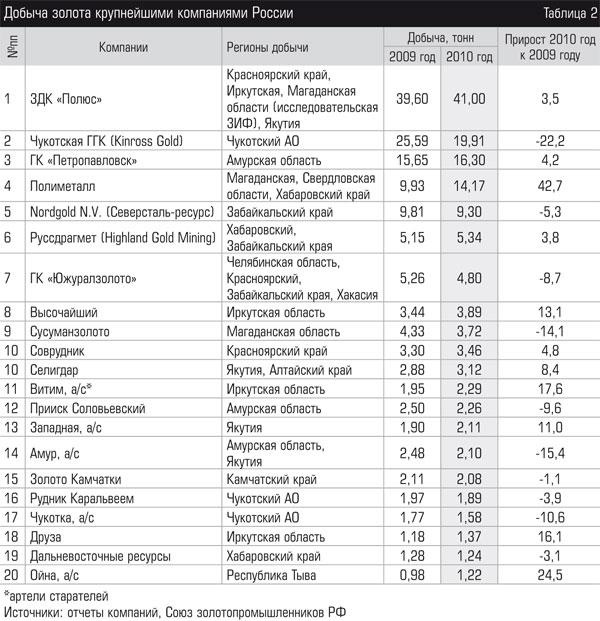
The largest gold mining companies in Russia.
Forecast for the next decade
Consumer demand for gold in the world is declining due to rising prices for the precious metal. Thus, at the end of 2021, retail purchases fell to a 10-year low, and demand for gold jewelry decreased by 6%.
It is expected that this trend will continue in 2021. Against the backdrop of the predicted financial crisis, the precious metal will strengthen in price. The London Bullion Market (LBMA) believes that the average price of gold will remain at $1,559, which is 12% higher than in 2021 ($1,392). The international association published this forecast in February 2021.
According to experts, the role of gold as a protective asset against dollar fluctuations remains. Against the backdrop of financial and geopolitical tensions, investment demand for the precious metal has increased significantly. Thus, in 2021, investments increased by 426% (to $19.2 billion).
According to forecasts of financial analysts, in the next 3-4 years the trend of growth in gold production will continue (by 1-2%), but then it will begin to decline. Among the reasons are the depletion of existing fields, as well as minimal investments in the development of new ones.
The research company GFMS suggests that in the next 10 years, China will maintain leadership, but production rates in Indonesia and South Africa will fall. At the same time, the positions of Mexico, Australia, the Russian Federation and Uzbekistan will be strengthened due to the opening of new projects.
Mining process
Gold production volumes varied depending on technological progress in the world. In the early days, manual mining was popular. Using the simplest and simplest designs and physical effort, the diggers obtained a small amount of gold sand. Sand was collected into a tray or strainer and shaken out into the water stream. Under the influence of the current, the sand was washed away, and only grains of gold remained at the bottom. This method is still effective today.
There are many other methods known in world practice that are known for their effectiveness and efficiency. For example, previously a river could erode a gold mine and throw the precious metal ashore. But already at the beginning of the twentieth century, people learned to extract nuggets from ore.
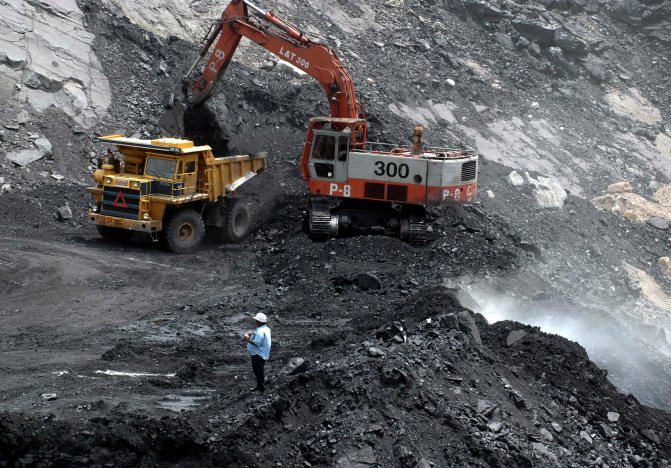
Open pit mining.
Nowadays there is a variety of equipment that helps in this process, so almost no one does manual mining. Despite the availability of modern technologies, the process of mining and excavation remains complex and lengthy. In order to understand how gold mining works and how profitable it is in the world, there is a special table. According to it, a mine can be considered profitable if it contains 3 grams of pure gold per thousand kilograms of earth or ore. If the volume of gold is 10 grams or more, then such a deposit is considered rich.
Gold and foreign exchange reserves
The history of gold mining begins with the Copper Age. Since then, more than 200 thousand tons of precious metal have been mined in the world. The bulk of it in the form of bullion is stored in national banks. Gold and foreign exchange reserves are required:
- to maintain the national currency;
- stabilization of its course;
- as a cash reserve during a crisis.
For example, after the global crisis of 2008, all countries had to replenish their gold and foreign exchange reserves. Leaders in gold and foreign exchange reserves at the beginning of 2021:
| Region | A country | Gold and foreign exchange reserves (tons) |
| North America | USA | 8133,5 |
| Europe | Germany | 3377,9 |
| Europe | Italy | 2451,8 |
| Europe | France | 2435,8 |
| East Asia | China | 1842,6 |
| Former USSR countries | Russia | 1615,2 |
| Europe | Switzerland | 1040,0 |
| East Asia | Japan | 765,22 |
| Europe | Netherlands | 612,5 |
| East Asia | India | 557,8 |
| East Asia | Taiwan | 423,63 |
| Europe | Portugal | 382,5 |
| Middle East | Türkiye | 377,1 |
| Middle East | Saudi Arabia | 322,9 |
| Europe | Great Britain | 310,3 |
| Middle East | Lebanon | 286,83 |
| Europe | Spain | 281,58 |
| Europe | Austria | 279,99 |
| Former USSR countries | Kazakhstan | 258,1 |
| Europe | Belgium | 227,4 |
The total volume of the world gold reserve is more than 32.61 thousand tons. This also includes stocks:
- IMF –2.81 thousand tons.
- ECB – 504.8 tons.
- BMR – 104 tons.
- TsBGZA – 36.5 tons.
A significant portion of the precious metal is privately owned. Almost 18 thousand tons of precious metal are concentrated in the hands of large Indian businessmen alone, which significantly exceeds the state reserves.
Methods of extraction from ore
Amalgamation is an extraction method that was used only a couple of decades ago. This method is based on mercury, which has the natural property of enveloping gold. At the bottom of a wooden barrel, mercury was placed into which rock with a certain content of the noble metal was poured. As a result of the chemical process, even the smallest particles stuck to the mercury.
In order to peel gold from mercury, it must be heated over a fire or on an electric stove. The only drawback of this extraction method is that mercury transfers a certain amount of its toxic elements to the metal.
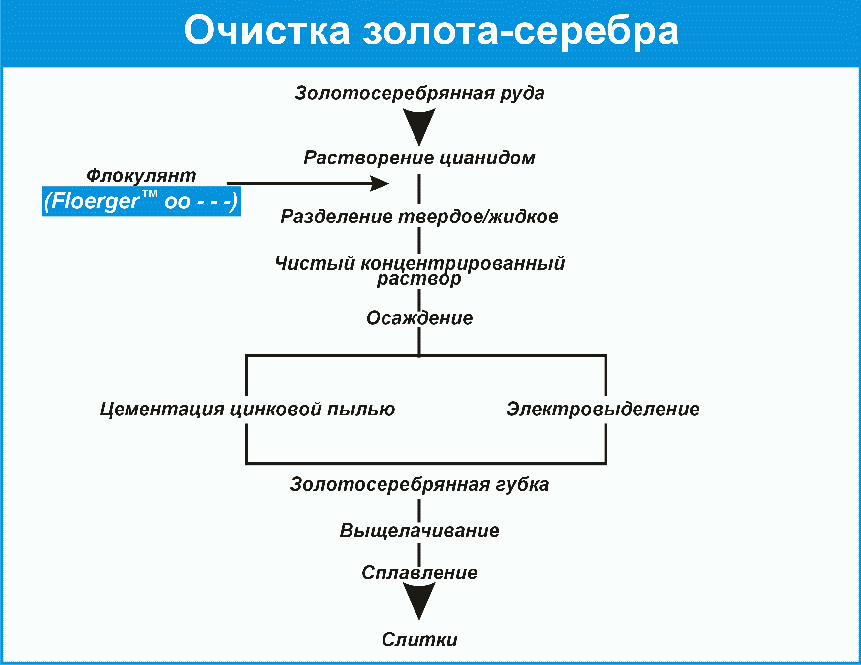
World gold mining is also known for the second method, which involves the use of sodium cyanide. This chemical element promotes certain processes that can make even those deposits that have long been considered abandoned profitable and quite profitable.
Quotes in 1996–2001
Gold statistics show that short-term investments are fraught with high risks. They are caused by the state of the world economy. Gold price statistics recorded a sharp decline from 1996 to 2001. Gold mining companies were forced to:
- reduce the volume of geological exploration;
- close unprofitable mines;
- introduce capital-saving technologies;
- transfer metal mining to countries with cheap labor.
The measures taken contributed to reducing the cost of gold mining. The situation changed after the terrorist attack of September 11, 2001 and the collapse of the American stock market. Gold rate statistics have changed slightly. Cost per ounce:
- the day before the terrorist attack – $271;
- a week later – $293.
Geography of production
It's time to talk about those countries and states where gold is mined progressively and profitably in the world. In recent years, the geography of production has changed greatly, and these changes have acquired large-scale significance.
In the early eighties, gold reserves were replenished every year by almost 950 tons. The Republic of South Africa provided 70% of all gold production. Already in the early nineties, South Africa, which was one of the richest countries on the continent, reduced its income level to 35% due to a drop in gold exploration.
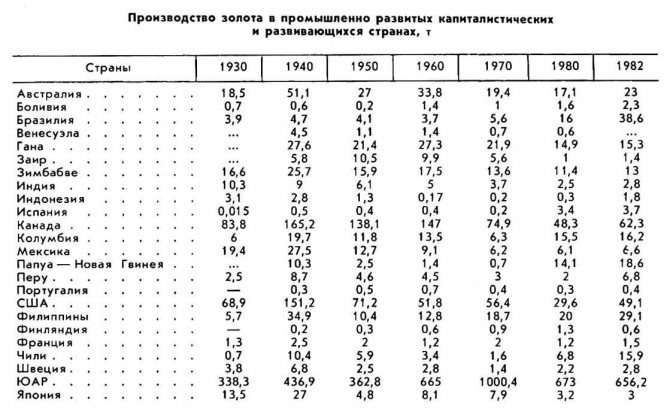
Along with this, some Western countries, on the contrary, began to develop and progress in the production of gold reserves. For example, Australia increased production volumes to almost 245 tons per year. In the southwest of the Pacific Ocean, new territories were discovered, which also began to be processed for the extraction of the yellow metal. Such territories include Papua New Guinea, Indonesia, and the sunny Philippines. Latin America has similarly increased its level of development.
From the mid-90s to the early 2000s, the ranking of countries that specialize in gold mining changed significantly.
It was during this period of time that the cost of the precious metal dropped significantly, so companies involved in the production and processing of gold tried their best to reduce the amount of financial costs.

Distribution by country in the 21st century.
First of all, all mines were closed, which, due to their unprofitability, did not generate significant income. The overall volume of preliminary activities to study land and water for the content of the required material was also reduced. A variety of technologies were used that saved money. The volume of work increased in those regions where labor was relatively cheap.
Mining Opportunities
Gold mining locations change periodically. The reason is that new, more promising deposits are being developed. There are thousands of abandoned mines in the country. They lost industrial importance due to the high cost of gold mining.
Abandoned mines become targets for illegal mining of precious metal. Gold statistics show that the volume of the “Black Market” in Russia is about 40 billion rubles. Methods for extracting gold by illegal miners:
- tray;
- mini dredge;
- gateway for gold mining.
Mining artels for gold mining decide to undertake hard and risky work due to vital necessity. This is how gold mining was once revived in the USSR. After the Civil War, private miners were allocated plots, provided with tax benefits, and were given bonuses for good work. Permission to mine gold was issued to everyone. The only requirement is no criminal record.
Gold statistics show that the legalization of gold mining made it possible to increase the production of the precious metal fivefold in just 10 years (1932–1941). More than 120 thousand people were engaged in handicrafts. Numerous reception desks kept records of gold mining. Many new deposits were discovered by private miners. Industrial development was subsequently organized on them. Legalization of artisanal gold mining in the Russian Federation could solve the following problems:
- reducing unemployment in the regions;
- attracting people to sparsely populated areas;
- increasing volumes of precious metal mining in Siberia;
- filling the treasury through the delivery of precious metal by miners.
Who produces more
In the eighties, Canada and the United States of America were responsible for providing the West with gold. In the second half of the nineties, these countries experienced a certain stability in the production of precious metals, but the industry soon fell into decline.
In recent years, it has been noticed that many gold mining enterprises from around the world have begun to unite with each other. This is because the larger scale of the company provides greater opportunities.
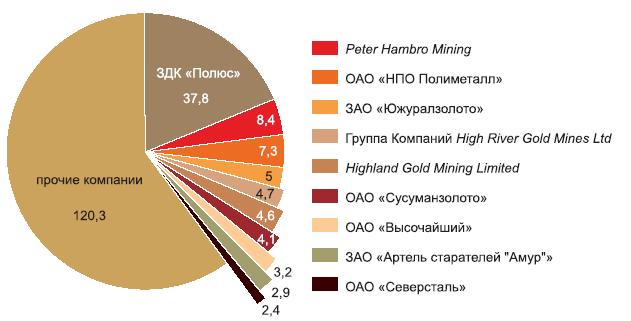
Industry leading companies.
It is clear that the list of progressive African and European countries in gold mining has expanded significantly, but not all of these states were considered successful in this matter. Fierce competition and struggle left only those countries that had the strongest and most stable economies able to mine nuggets.
From time to time, the territorial structure of countries that engage in gold mining changes. In this fight, China still holds a confident lead.
We are currently living in a period of widespread financial crisis. In such conditions, the cost of gold is rapidly increasing. Such a crisis prompted the owners of many companies to expand the volume of work during the period of rising prices.
Despite the fact that the leading gold mining countries are replenishing world reserves, they cannot in any way influence the price of the metal. Therefore, they have to adjust their production to fluctuations in prices on the world market, and also fulfill orders as quickly as possible in order to maintain the profitability of their mines.

Gold prices are mostly determined on stock exchanges.
Since ancient times, it has developed that most of the gold is spent on the production of jewelry. The prevalence of jewelry directly depends on its price. The lower the cost, the more actively they are purchased. In conditions of significant economic recovery, this pattern changes slightly in the opposite direction.
Thus, you have learned how gold reserves are mined in various ways, as well as in which countries of the world gold is actively mined, but you still do not know that you can mine gold in small quantities yourself.
TOP 10 gold producing countries
The 10 largest gold producing countries account for 64% of the total. Until 2006, South Africa was the absolute leader. Now, China has been the champion manufacturer for more than 10 years.
Top 10 largest gold producing countries (data at the end of 2021 and at the beginning of 2021):
- China
- Russia
- Australia
- USA
- Canada
- Peru
- South Africa
- Indonesia
- Mexico
- Ghana
Did you know that...
No country has matched South Africa's record production level of 1000 tonnes per year in the 1970s!
China
For the 13th year in a row, China has maintained its leadership. It accounts for more than 13% of global production. The liberalization of the gold market, which began in 2003, helped attract foreign investors, which increased production volumes.
The bulk of the gold is located in underground mines in eastern China. All of them are controlled by the state through the China National Gold Group Corporation (CNGGC). These are more than 450 mines, which yield up to 20% of the metal.
According to the China Gold Association (CGA), 380 tons of metal were mined in the country in 2021. The figure is high, but if compared over time, it is 5% lower than in 2021. This is due to the government tightening measures to combat environmental pollution.
Russia
According to the Ministry of Finance of the Russian Federation, gold production volumes in the country in 2021 increased by 9% and amounted to 343 tons. Of these, 286 tons came from production from deposits.
For the second year in a row, experts have recorded an increase in gold production in the Russian Federation. This was influenced by the increase in gold production from mineral raw materials, as well as the launch of new projects. In particular, we are talking about the Sukhoi Log deposit (Eastern Siberia), which is estimated to contain more than 1960 tons of gold!
The main gold-bearing region remains Siberia, where mining is carried out from primary (more than 100) and alluvial deposits. For the last many years they have held the championship in the world. However, their share in total production is gradually decreasing due to the depletion of deposits. According to forecasts, with annual production from placers exceeding 80 tons, this fund will be exhausted in less than 10 years.
Australia
Gold accounts for more than half of Australia's exports and accounts for 9.4% (315 tonnes) of global production.
The country has 5 of the 20 largest gold deposits.
The country plans to reach its peak national gold production of 339 tonnes in 2021, a government survey said. But in subsequent years, a gradual decline in production is expected due to the closure of old fields.
Did you know that...
In Australia, anyone can mine gold with a private mining license.
USA
According to the leading financial analytical publication The Thomson Reuters, the United States has held fourth place in the ranking for the past few years. Today, mining occurs in 30 states, centered on Nevada, which produces about 80% of all American gold.
In 2018-2019 overall production of the precious metal in the country fell. Thus, in the period from January to August 2021, this figure decreased by 12% and amounted to 139 tons.
According to the United States Geological Survey (USGS), gold production in January-February 2021 froze at a low level of 17 tons due to the closure of many companies due to the coronavirus.
Canada
The state of Ontario and neighboring Quebec are the country's main gold-mining regions. Canadian mines cannot be called large, but the country is gradually increasing production volumes. How does she do this? First of all, thanks to the discovery of new deposits and the construction of enterprises. In addition, in 2012, Canadian companies topped the list of the most active buyers in the gold mining sector.
At the end of 2021, gold production and extraction volumes in Canada amounted to 193 tons. The analytical center Mining Intelligence Center predicts that until 2023 this figure will grow by 2.7% annually and in 4 years will amount to 236 tons. It is expected that this will be facilitated by the launch of new projects.
Peru
Peru ranks 6th in the world with production of 169 tons. According to a study by the analytical company S&P Global Market Intelligence, gold production in the country has reached its minimum, since no new deposits have been discovered in the country over the past three years.
There are 160 companies involved in legal gold mining in Peru. Moreover, 15% of all precious metals mined comes from illegal activities.
Did you know that...
In Peru, earnings from illegal gold production are twice as high as income from drug trafficking!
Illegal gold mining has devastated vast areas. In February 2021, Peruvian authorities sent 1,500 police and soldiers to combat illegal gold mining. The military burned the huts of illegal immigrants, which led to a surge in crime in the region.
South Africa
After the development of the richest deposits, the level of gold production in South Africa is decreasing from year to year.
In 2006, South Africa lost its lead and continues to decline in the ranking of producers. Now the country ranks 7th with a production volume of 164 tons (according to Thomson Reuters GFMS).
According to official data, there are more than 1,000 mining enterprises in the country. Large gold mines (about 35) are concentrated in two provinces - Gauteng and the Free State.
Indonesia
Official gold production in Indonesia is 97 tons per year, while about 20 tons are mined illegally annually.
Indonesia is home to the world's largest gold deposits - Grasberg and Batu Hijau.
At the Grasberg gold mine, daily production waste amounts to 200,000 tons of waste. They turn entire forests into wastelands!
Gold production has been declining since 2021 due to stricter environmental controls.
Mexico
The country's mining policy is open to foreign miners. According to official data, there are currently 293 foreign companies operating in Mexico (mostly from Canada and the USA). With the participation of foreign capital, more than 760 projects for the extraction and exploration of precious metals are being implemented!
The total share of foreign investment in Mexico's mining sector is 60%, and in exploration projects - 70%.
According to the Thomson Reuters GFMS analytical company, 118 tons of gold were mined in the country in 2014.
Due to foreign investors, the overall level of metal production shows positive dynamics. Reports from the Mexican Institute of Statistics say the country produced 9.5 tons of gold in January 2021, up from 9.3 a year earlier.
Ghana
Ghana is Africa's largest gold supplier. It closes the top ten world leaders in gold mining with an indicator of 102 tons. Gold accounts for 95% of the country's mining industry revenues.
Foreign direct investment in gold accounts for more than 50% of the total level of investment in the country!
There are more than 15 state-owned companies in the Ghana gold mining industry, as well as more than 10 foreign ones. The country's largest gold mine, Tarkwa, is owned by the South African company Gold Fields (90%) and the state (10%).
Getting gold at home
If you have some knowledge in the field of mining and processing of precious metals, then it is quite possible to establish the production of pure gold at home. To do this, it is not at all necessary to travel hundreds of kilometers to the location of the mines or sit for hours on the river bank with trays.
In reality, we are surrounded by a large number of objects from which this mineral can be extracted. For example, old Soviet-made watches contained pure gold in their case, without any impurities.
In order to get the desired result, you need to have a large number of such watches. For extraction you will need the following items and tools:
- Capacious plastic bucket;
- Plastic or metal basin;
- Electric stove;
- Several sharp razor blades;
- Fireproof glass pan;
- Brush and piece of fabric;
- Rubber gloves, as well as a spray bottle.
Chemicals you may need include hydrochloric acid and aqua regia. The recycling process can only begin when there are at least 300 cases available. The entire extraction process takes only 4 hours, requiring about 4 liters of acid. From the total amount of gold-containing watches, 75 grams of pure gold can be smelted.
Obtaining gold using the etching method
Few people might have thought about it, some might simply not know, but almost every person on the planet carries a small piece of yellow metal with them every day. Any telephone SIM card contains a certain amount of gold. Some countries of the world and Europe that mine gold even extract it from such items in the process of recycling waste.
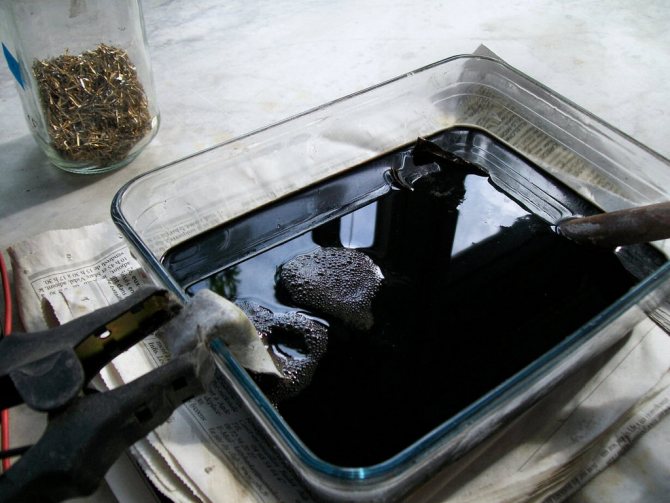
Electrolysis technology.
This can only be done in two ways:
- Electrolysis;
- By etching.
To use the second method, you need to use nitric acid, which is popularly known as aqua regia. Etching is the most common and popular method. It is convenient due to its simplicity, as well as the natural property of gold to interact with many other metals and elements.
Gold from water
Gold particles can be found in any water: from clean drinking water to sewer or sea water. The only peculiarity is that the amount of metal in it is very small. It is extracted using quicklime. In order to extract eighteen grams of pure gold, you need to spend a ton of lime.
If we consider the example of sea water, then to process it it is necessary to mix it with lime-based milk. After a certain period of time, the water is again poured back into the sea, and the precious metal can be extracted from the sediment that remains at the bottom of the container.
